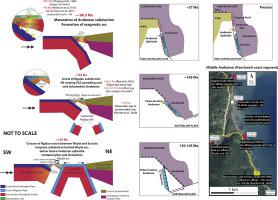Our official English website, www.x-mol.net, welcomes your
feedback! (Note: you will need to create a separate account there.)
Geochemical and geochronological record of the Andaman Ophiolite, SE Asia: From back-arc to forearc during subduction polarity reversal?
Lithos ( IF 2.9 ) Pub Date : 2021-01-01 , DOI: 10.1016/j.lithos.2020.105853 Debaditya Bandyopadhyay , Biswajit Ghosh , Carl Guilmette , Alexis Plunder , Fernando Corfu , Eldert L. Advokaat , Pinaki C. Bandopadhyay , Douwe J.J. van Hinsbergen
Lithos ( IF 2.9 ) Pub Date : 2021-01-01 , DOI: 10.1016/j.lithos.2020.105853 Debaditya Bandyopadhyay , Biswajit Ghosh , Carl Guilmette , Alexis Plunder , Fernando Corfu , Eldert L. Advokaat , Pinaki C. Bandopadhyay , Douwe J.J. van Hinsbergen

|
Abstract Ophiolites are widely studied to unravel how new subduction zones form. They may contain crustal and mantle rocks that formed during juvenile stages of intra-oceanic subduction, modifying the pre-existing oceanic lithosphere within which subduction started, and in which a magmatic arc formed upon subduction maturation. Previous geochemical work on the Cretaceous Andaman Ophiolite and its metamorphic sole, located in the forearc of the Sunda subduction zone of south-east Asia, has revealed geochemical signatures that are difficult to reconcile in a single tectonic setting but may rather record different stages in a longer evolution. A recent kinematic reconstruction proposed that the Andaman Ophiolite may have formed during subduction initiation in a former back-arc basin, when the former (Woyla) arc collided with the Sundaland continent. Here, we evaluate whether such a scenario may provide a feasible context to explain the enigmatic geochemical signatures preserved in the Andaman Ophiolite. To this end, we provide new, and review existing geochemical as well as geochronological constraints on the formation of its crustal rocks, as well as the evolution of its mantle portion. We identify mafic magmatic rocks and cogenetic plagiogranites that are consistent with formation in a magmatic arc, whereas other magmatic rocks, as well as metamorphic sole protoliths, have characteristics indicative of a back-arc origin. Three new, and two previous zircon U/Pb ages of arc magmatic rocks give a 99–93 Ma age range, but we also identify an inherited ~105 Ma age. This latter age coincides with Ar/Ar cooling ages of the Andaman metamorphic sole, and with a plagioclase xenocryst age from recent Barren Island volcanics east of Andaman. The geochemical and geochronological constraints of the Andaman ophiolites are straightforwardly explained in the context of the regional kinematic history: (1) The original lithosphere formed in the back-arc basin of the Woyla intra-oceanic arc; (2) Subduction initiation and SSZ ophiolite formation within this basin occurred around or slightly before 105 Ma; (3) This was followed by arc magmatism between 99 and 93 Ma upon subduction maturation.
中文翻译:

东南亚安达曼蛇绿岩的地球化学和年代学记录:在俯冲极性反转期间从弧后到弧前?
摘要蛇绿岩被广泛研究以解开新的俯冲带是如何形成的。它们可能包含在洋内俯冲的幼年阶段形成的地壳和地幔岩石,改变了俯冲开始的先前存在的海洋岩石圈,并在俯冲成熟时形成了岩浆弧。先前对位于东南亚巽他俯冲带前弧的白垩纪安达曼蛇绿岩及其变质底部的地球化学研究揭示了在单一构造环境中难以协调的地球化学特征,但可能更愿意记录不同阶段的地球化学特征。更长的进化。最近的运动学重建提出,安达曼蛇绿岩可能是在前弧后盆地的俯冲开始期间形成的,当时前(Woyla)弧与巽他大陆相撞。在这里,我们评估这种情景是否可以提供一个可行的背景来解释保存在安达曼蛇绿岩中的神秘地球化学特征。为此,我们提供了新的并回顾了对其地壳岩石形成及其地幔部分演化的现有地球化学和地质年代限制。我们确定了与岩浆弧形成一致的基性岩浆岩和共生斜长花岗岩,而其他岩浆岩以及变质的单一原岩具有表明弧后起源的特征。弧岩浆岩的三个新的和两个以前的锆石 U/Pb 年龄给出了 99-93 Ma 年龄范围,但我们也确定了一个继承的 ~105 Ma 年龄。后一个时代与安达曼变质底部的 Ar/Ar 冷却时代相吻合,以及来自安达曼以东最近的贫瘠岛火山的斜长石异晶时代。安达曼蛇绿岩的地球化学和年代学约束在区域运动史背景下得到了直接解释:(1)原始岩石圈形成于Woyla洋内弧的弧后盆地;(2) 盆地内俯冲开始和SSZ蛇绿岩形成发生在105 Ma前后;(3) 随后在俯冲成熟时发生 99-93 Ma 之间的弧形岩浆活动。(2) 盆地内俯冲开始和SSZ蛇绿岩形成发生在105 Ma前后;(3) 随后在俯冲成熟时发生了 99~93 Ma 之间的弧形岩浆活动。(2) 盆地内俯冲开始和SSZ蛇绿岩形成发生在105 Ma前后;(3) 随后在俯冲成熟时发生 99-93 Ma 之间的弧形岩浆活动。
更新日期:2021-01-01
中文翻译:

东南亚安达曼蛇绿岩的地球化学和年代学记录:在俯冲极性反转期间从弧后到弧前?
摘要蛇绿岩被广泛研究以解开新的俯冲带是如何形成的。它们可能包含在洋内俯冲的幼年阶段形成的地壳和地幔岩石,改变了俯冲开始的先前存在的海洋岩石圈,并在俯冲成熟时形成了岩浆弧。先前对位于东南亚巽他俯冲带前弧的白垩纪安达曼蛇绿岩及其变质底部的地球化学研究揭示了在单一构造环境中难以协调的地球化学特征,但可能更愿意记录不同阶段的地球化学特征。更长的进化。最近的运动学重建提出,安达曼蛇绿岩可能是在前弧后盆地的俯冲开始期间形成的,当时前(Woyla)弧与巽他大陆相撞。在这里,我们评估这种情景是否可以提供一个可行的背景来解释保存在安达曼蛇绿岩中的神秘地球化学特征。为此,我们提供了新的并回顾了对其地壳岩石形成及其地幔部分演化的现有地球化学和地质年代限制。我们确定了与岩浆弧形成一致的基性岩浆岩和共生斜长花岗岩,而其他岩浆岩以及变质的单一原岩具有表明弧后起源的特征。弧岩浆岩的三个新的和两个以前的锆石 U/Pb 年龄给出了 99-93 Ma 年龄范围,但我们也确定了一个继承的 ~105 Ma 年龄。后一个时代与安达曼变质底部的 Ar/Ar 冷却时代相吻合,以及来自安达曼以东最近的贫瘠岛火山的斜长石异晶时代。安达曼蛇绿岩的地球化学和年代学约束在区域运动史背景下得到了直接解释:(1)原始岩石圈形成于Woyla洋内弧的弧后盆地;(2) 盆地内俯冲开始和SSZ蛇绿岩形成发生在105 Ma前后;(3) 随后在俯冲成熟时发生 99-93 Ma 之间的弧形岩浆活动。(2) 盆地内俯冲开始和SSZ蛇绿岩形成发生在105 Ma前后;(3) 随后在俯冲成熟时发生了 99~93 Ma 之间的弧形岩浆活动。(2) 盆地内俯冲开始和SSZ蛇绿岩形成发生在105 Ma前后;(3) 随后在俯冲成熟时发生 99-93 Ma 之间的弧形岩浆活动。









































 京公网安备 11010802027423号
京公网安备 11010802027423号